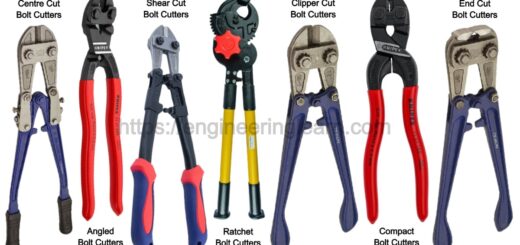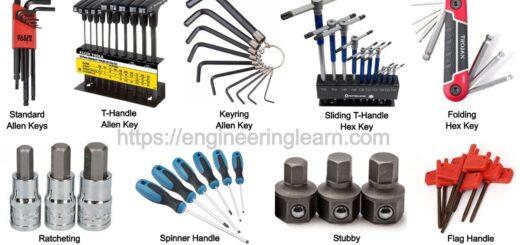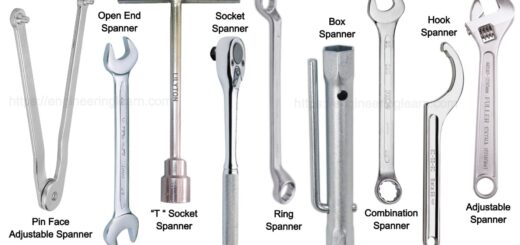Types of Forging Tools and Their Uses [with Pictures]
![Types of Forging Tools and Their Uses [with Pictures]](https://engineeringlearn.com/wp-content/uploads/2021/08/Forging-Tools-1024x539.jpg)
What is Forging?
Types of Forging Tools and Their Uses [with Pictures] :- A forging is process of changing shapes of parts by applying impact loads with the help of hammer. A forging is carried out by heating a metal part in an open fire or hearth at an elevated temperature and hammering it by using blacksmith to deform it completely. Thus forging is defines as the plastic deformation of metal part sat an elevated temperature changes or altering the shape and size of parts completely.
A forging is performed at an elevated temperature of 980 degree centigrade at which metal is completely plastic and able to deform easily in any shape and size It is carried out in a workshop which is known as smithy shop. There are different types of forging tools which are used in forging operations.
Types of Forging Tools
- Tongs 8. Rivet header
- Swage 9. Hammers
- Punch 10. Swage block
- Hot Chisel 11. Set Hammer
- Anvil 12. Hardie
- Drift 13. Break Iron
- Fuller 14. Flatter
1. Tongs: ( Types of Forging Tools )
The tongs are mainly used for holding workpiece while doing a forging operation. There are various types of tongs used for different types of work piece.
- Flat tongs-Used for holding workpiece of rectangular section.
- Straight lip fluted tongs- Used for holding square, circular and hexagonal shaped bar.
- Rivet or ring tong-Used for holding bolts, rivets and other workpiece of circular section.
- Gad tongs- Used for holding general pick-up workpiece, either straight or tapered.
2. Swage: ( Types of Forging Tools )
Swage is used for forging operations which has to be done to round, square or hexagonal form. It has a handle at the top and a square shank at the bottom.
3. Punch: ( Types of Forging Tools )
Punch is used to make holes hot metal part while performing forging operations. To make hole simply put the thinner part of the punch on the hot metal part and apply compressive load by hammering. There are two types of punches, Dot punch which has an angle of tip about 60 degree and Centre punch with angle of tip about 90 degree.
4. Chisels: ( Types of Forging Tools )
Chisels are used for cutting metals. They may be hot or cold depending on whether the workpiece to be cut is hot or cold. A hot chisel mainly used in forging shop. The difference between the two is in the edge. The edges of cold chisel are at an angle of 60 degree, whereas the edges of a hot chisel are at an angle of 30 degree. The hardening and tempering is required in cold chisel, whilst hardening is not required in hot chisel. The edge is made slightly rounded for efficient cutting action.
5. Anvil: ( Types of Forging Tools )
Anvil is a main tool used in forging shops which supports the blacksmith’s work while hammering. The anvil is made of mild steel with a tool steel face welded on the top. The anvil contains a circular hole at the top surface known as pritchel hole is commonly used to bend rods of smaller diameter and as a die for hot punching actions. The square hole is generally used for holding square shanks of various fittings which is known as hardie hole. The weight of the anvil in forging shop is about 100 kg to 150 kg and its top face should stand about 0.75 mt. from the floor.
6. Drift: ( Types of Forging Tools )
It is a tapered rod used in forging shop made of tool steel. It generally used to open holes by driving through a larger tapered punch known as a drift. It has small diameter in comparison of hammer face due to this force can be concentrated into a smaller area. Drift is not used like a punch; it helps to remove dents from inaccessible places.
7. Fuller: ( Types of Forging Tools )
Fuller is a tool which is used to necking down a forgeable job in forging shop. It comes in different shapes and sizes according to requirement and the size represents the width of the fuller edge. It spreads the metal workpiece when the metal is in plastic form by applying compressive loads. The round shaped face of the fuller spreads metal more efficiently and easily in comparison of flat surface of hammer.
8. Rivet Header: ( Types of Forging Tools )
It produces rivet heads on work piece in forging shop.
9. Hammer: ( Types of Forging Tools )
Hammer is a tool which are used in forging shop to deform or alter shapes of workpiece by hammering. It has a heavy head fixed to a long handle which gives the high intensity impact load on the small area of workpiece. There are two types of hammers–









